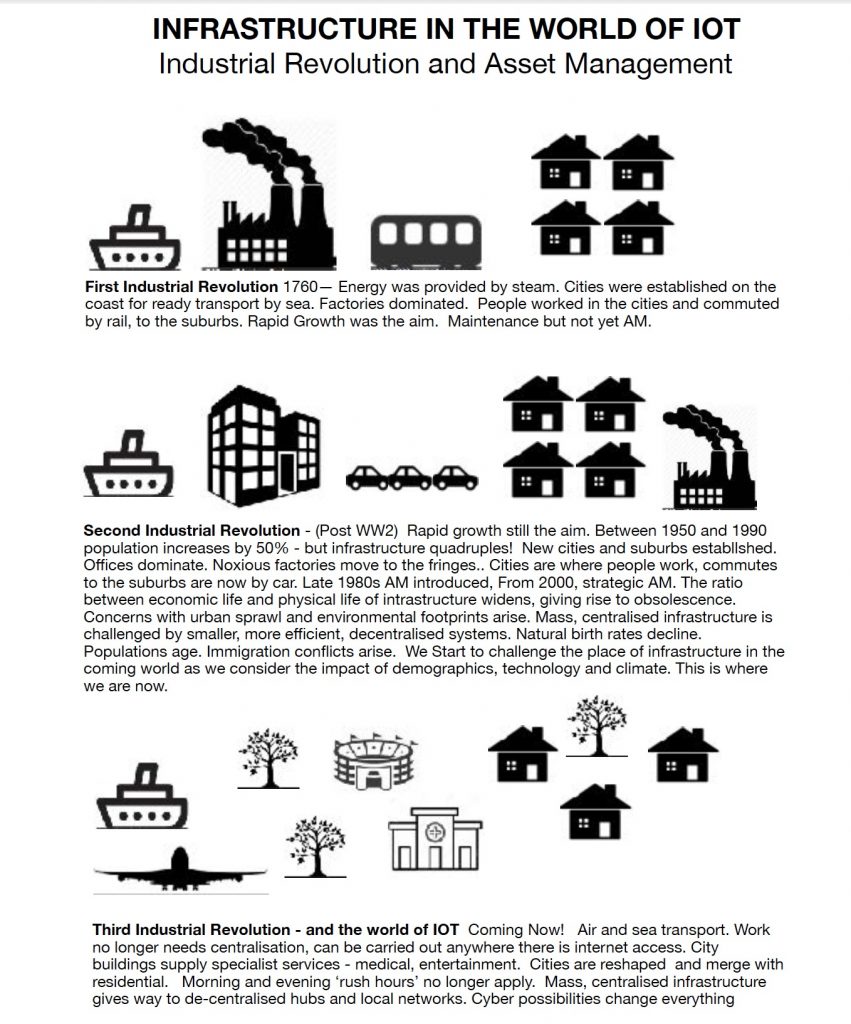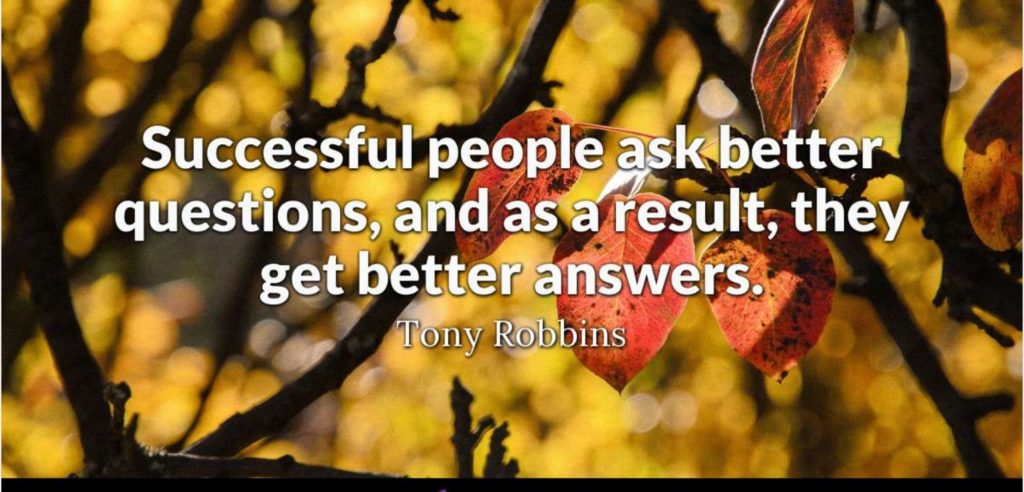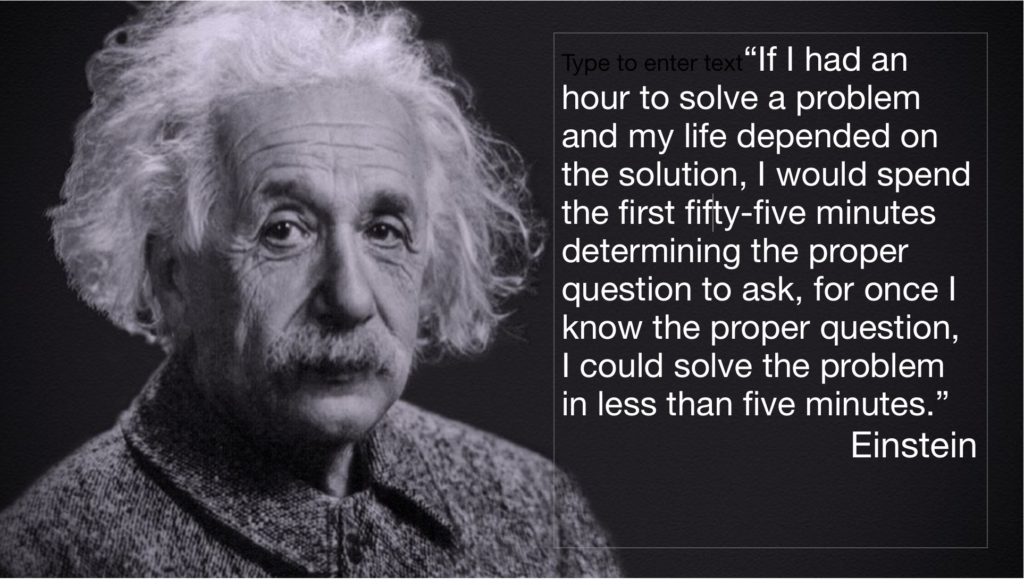
Photo by Miriam Espacio
It is rare to come up with 5 new directions from a single conference after 30 years of attending. But the last 2 days at the Sydney ‘Asset Management for Critical Infrastructure’ conference, I did, and I am both excited and grateful. There is nothing like a nice idea to wrap your head around. Here, in brief, is early notification of what I will probably be thinking and writing about in the next several weeks (even months). Please join me in exploration.
1. Business Cases
I made a disparaging comment about the quality of business cases and was taken up on the issue. “Why so bad?” he asked. I thought that there was probably three reasons. 1. We come at them with the wrong attitude. We don’t ask, ‘is this project justifiable?’ and then seek the information on costs and benefits that would enable us to answer the question, instead we start from the biased position of ‘how can we prove that this project should go ahead?’ Under these circumstances it is not surprising we have a tendency to overstate the benefits and understate the costs. 2. It is a genuinely difficult thing to figure out the benefits of infrastructure, for they usually reach way beyond the immediate recipients of the infrastructure service. I have also found, surprising as this might sound, that there is genuine difficulty for many in determining what is a benefit and what is a cost. 3. There is a lack of independence. I was told (who by?) that in Germany the C/B studies are done independently. This would be a great help if we were to adopt that here. It would overcome the first two issues and enable all projects to be considered on an equal footing as well as allowing the evaluation body to develop real evalution skill.
2. AM Ethics
Ashley Bishop had asked, in a comment to an earlier post, how AM could develop as a profession. I had given a keynote address on this many years back, but not covered one particular aspect that a fellow raised yesterday (who?). He said that we couldn’t become a profession until we developed a set of professional ethics. Fascinating! I started to wonder what such a set of professional ethics might look like? I would love to hear from anybody who also finds this an interesting question.
3. The Boom that never ends
Andrew O’Connor, KPMG had made it clear that we are currently experiencing a boom in infrastructure spending. Except that it isn’t! At least it isn’t if we are to believe new Infrastructure Australia CEO, Romily Madew, who argued that this level of spending is now ‘the new normal’. Booms come to an end, that is the nature of a boom, they don’t become the ‘new normal’. Capital spending over the next 10 years is about double that of the previous ten or around 100% growth. Justified by population increase? But that is only expected to be less than 25%. If this level is to be the ‘new normal’, it means we will continue to spend on infrastructure at about 4 times the rate of population growth! Does this sound normal? Let alone necessary and possible? And I am only looking at continuation of the level, if we look at continuation of the ‘rate of growth’, the problem assumes an even scarier dimension. What on earth are we thinking here? – to be explored.
4. Selective projections
All spending projections focus on capital costs. But every time we build a hospital, the recurrent costs (medical staff, cleaning staff, medical consumables, as well as the infrastructure operations and maintenance costs) easily come to about 40-50% of the capital costs, and they do this every year. Schools and Universities also have a high recurrent to capital ratio. Utilities less so, and probably roads the least of all, nevertheless even at the lowest level we are looking at around 10% of the capital cost as an ongoing recurrent cost. These costs continue even when the ‘boom’ has passed. Tom Carpenter said that in Japan, forecasts include both capital and recurrent. This is a much safer management process. If they can, why can’t we?
5. Infrastructure Debt and national security
Where are we getting the money from for this infrastructure spending? And how much are we paying for it? Already the University sector is financially dependent on China (as reported in the AFR, 21 August). How soon before all sectors are? Romily Madew, CEO, Infrastructure Austraia, said that this question was not within her remit. She thought it maybe was being done in the Treasury. Who is keeping an eye on this? The University sector has become dependent on Chinese funds simply because the Federal Government took short term decisions. It didn’t see today’s consequences. Maybe it is about time we took a serious look before this all gets out of hand. To be explored – does anyone know where this is being examined?
If any of these ideas intrigue you and you would like to work with me to see where these ideas can go – please write to me at penny@TalkingInfrastructure.com.

Photo by Matheus Bertelli
“How did you get involved in asset management?”
I asked this question some years ago and this answer blew me away! For sheer excitement and enthusiasm, it is a marketing masterpiece. I haven’t been able to improve on it – can you?
Michael Brendali wrote: “My involvement and keen interest in asset management began in the second-half of 2008. I was a mechanical design engineer finishing up a long and enjoyable stint on the Sydney Desalination Project when I was asked to contribute to a project we (Sinclair Knight Merz) were undertaking to evolve the asset management strategy for a major urban water utility’s critical infrastructure.
“The fun of complex decision-making from
physical to the business effectiveness”
I was initially meant to work for about one month on the project as my knowledge of their corporate databases would prove useful for one aspect of the project, but once I became involved I found the asset management field entirely engrossing. This was a world of complex decision-making, dealing with everything from the physical properties of pipes and soils, to the regulatory environment of the utility, to the effectiveness of internal business processes and knowledge management systems. A world that requires you to see the big picture while understanding the intricacies of the minutiae.
A world where on any given day I can be working with operators, maintenance crews, scientists, economists, planners, asset managers or general managers. I was hooked! I was able to expand my role on the project and so that original one month turned into a new career direction
“a collaborative environment”
I have worked in asset management ever since and am currently completing a Masters of Science degree in Water Services Management at UNESCO-IHE in Delft, the Netherlands. This degree focuses on the integration of legal, economic, institutional, organisational and technical considerations for the successful provision of infrastructure services. I am currently undertaking my MSc Thesis, which I am using to research the nature and effectiveness of the collaborative environment for sharing and progressing (strategic) asset management within the Australian urban water sector.
“taking ownership of challenges, even relishing them, and
sharing wisdom for the progression of the discipline”
The human factor of asset management strongly appeals to me. In the current era where we have available a multitude of software, tools, applications and models (which have their value), the indispensible nature of educated professionals with sharp minds cannot be forgotten. Indeed, I think that is one of the great strengths of the asset management community – it contains many talented individuals who take ownership of the challenges they face (perhaps even relish them) and willingly share their wisdom for the progression of the discipline. It is a community that makes me want to actively participate too.
“where you can enjoy debates at many levels”
I truly enjoy the many challenges present in asset management and the debates they spur at all different levels – qualitative versus quantitative analysis; prescriptive standards versus supportive guidelines; structural reform of utilities or the encouragement of voluntary alliances; maintenance or renewal; compliance versus innovation. I have come into the industry at a very interesting time and have been particularly fortunate to have had the guidance and encouragement of a very talented senior practitioner within my firm, as well as the support of my organisation. I can wholeheartedly endorse the value of mentorship on the development of a younger engineer.
“influencing decisions representing
hundreds of millions of dollars”
If I sound overly excited by asset management, it is because I find working in asset management deeply satisfying. I value the fact that the work I do contributes to the sustainable provision of essential services and that, thanks to strategic asset management, decisions influencing hundreds of millions of dollars of (often public) spending can be made prudently.
I look forward to the challenges ahead!”
Well, what do think? Is there anything that Michael has missed out? or new things that have come up since?
PS Michael, wherever you are now and whatever it is that you are doing I hope you still find work exciting. Do let me know what you are doing and I will update this post with your current details.

Today’s Asset Management Strategists
Today’s Asset Management Strategists need to ask new and different questions. We can no longer rely on answers that served us well in the past, nor the questions that generated those answers. We need to develop new question asking skills and explore new directions.
Over the last 30 years we have concentrated on efficient production, or ‘getting the job done right’ and done really well with that. Now we need to tackle the next task ‘getting the right job done’.
With so many technological options now opening up, and economic, social and environmental demands, as well as public and governance attitudes changing so rapidly- it may be a very, very, different job!
But it doesn’t have to be overwhelming.
We just need to know where to start.
In my last post I reflected on the public service in the late 1980s where I rejoiced in finding many others willing to co-operate in problem solving – before ‘competition’ rather than ‘collaboration’ became the ethos of the day.
However, there are now signs that the tide is again turning, so can we provide a vehicle for collaborative discussion? Let’s try!
Melbourne Workshops
I will be in Melbourne at the end of this month to conduct interviews for our podcast series and while I am there, the Talking Infrastructure Melbourne Team is organising a series of free workshops (coffee provided!) to explore new questioning techniques.
Here is what is on offer – Two hour workshops will be held at the Istana next to the Queen Vic Markets between Saturday 27 and Wednesday 31 – In the comments section, tell us what interests you and we will send you session times and more detail.
1. Inverse Hypotheticals
In an ordinary hypothetical a hypothetical story is created and panelists are asked questions. In an inverse hypothetical, a story is again created BUT it is the panelists who get to ask the questions. The set up is this: A review group has to consider a certain infrastructure proposal or situation. The panel are advisors to this review group and feed them the questions they feel relevant. The facilitator may throw some unexpected new items into the mix as the discussion develops.
2. Development Session: Exploring the role of the Future Asset Management Strategist
If you know the technique of ‘Beyond Bullet Points’, this is a great opportunity to practice. If not, it is a great opportunity to learn. And to produce something valuable in the process.
3. Exploration Session: “The 2020 Infrastructure Challenge”
Those of you who have been involved in asset management for a while will remember The International Asset Management Competitions which took place between 1996 and 2000. They were designed to put asset management, if not on the map, at least high on the priority list of CEOs. And it was very effective in giving asset management greater traction at that time. The 2020 Infrastructure Challenge is looking at how we might do the same for the new infrastructure decision making we will need as we transit for 20th to 21st century infrastructure.
4. Open Discussion Session
Key concerns of asset managers today, Come with your question and/or come to get involved in the ideas of others.
Not in Melbourne?
Workshops are being planned for other cities. At the moment we are looking at Sydney in mid August (while I am over Sydney way to give the opening keynote to the Asset Management for Critical infrastructure Conference, August 20th)

There is something about wet and windy overcast conditions that brings on reflection, which, if we are not careful, can lead us into melancholy. Avoiding this risk requires us to take action – and so I am. Read on to see the reason – and the action.
The way things were
In 1982 I moved from the University where academics were closely focused on their own projects, to the state water authority where – at that time – the focus was improved community outcomes. If I had an idea for improvement, it was not difficult to find half a dozen bright, well intentioned others, to willingly and co-operatively work through it with me. And, equally, there were many others willing to involve me in their ideas for improvement. The Public Service was a great place to be in the early 1980s. It changed, of course, with the introduction of modern commercial management ideas. And, ultimately, not for the better.
The way things are
This started the exodus of those who believed in community service and of the intelligent who could easily secure positions outside the government. Today, with short term public service contracts, there is no devotion to improved community outcomes – how can there be when one’s own short term outcome is so precarious, so insecure? There is also no corporate knowledge and information to draw upon. The community has lost out. The public service has lost out. Who has benefitted from this much vaunted ‘improved management’ shift?
The way things can be
Clearly I am not advocating for greater inefficiency, but I think we could do with improved effectiveness. I miss those days when community focus was the norm amongst the brightest and best. A time when, if I had an idea for allowing unprofitable irrigation farmers to sell those most valuable asset – access to water – to others who could make better use of it; or if I wanted to see whether the hype about the value of the Grand Prix could be proved, I could draw on the expertise of others simply by asking for it. That was how we started a review of irrigation water licences and put together academics and public servants to produce ‘The Adelaide Grand Prix’ – an analysis of the first Grand Prix in Australia in 1985. This was the first serious analysis of the impact of a Special Event, it has been cited in every publication on Special Events since then, and our approach was adopted by the Commonwealth Government in their grant assessments for many years – despite the hyped up arguments of some of the top management consulting companies. It prevented our State Government from following its earlier wish to contend for the Commonwealth Games – and thus avoided the ‘white elephant’ structures associated with these events.
Action now
Is it possible to replicate today those productive, well intentioned, discussions that served the greater good? I think it is. The growing strength on the non-private, non-government ‘Civil Society’ supports this. I also think it is essential that we develop a core of intelligent strategists to help manage the infrastructure shifts that will be necessary as we transit into a digital, increasingly complex, future.
Talking Infrastructure is looking to provide opportunities for those of you, from whatever disciplinary background, who aspire to be these future strategists, to physically get together with like-minded others for the purpose of sharing your ideas for improvement and assisting them in theirs – and in general developing your strategic ability to assist your organisations face the future. Does this interest you?
More information to come.

Can’t stand economists? I often don’t care much either – and I am one! But this week I am proud to be among the number of ‘new economists’, economists for whom human beings are actually people, and the whole reason why we engage in economic activity, and not mere dispensible cyphers in the production cycle.
Kate Raworth, author of “Doughnut Economics – Seven ways to think like a 21st century economist” and the team at Rethinking Economics got together to issue a challenge to find an 8th way. Contributors could use any medium but they had to tell their story in 3 minutes or less. There were three sections, one for schools, one for universities, and one for ‘everyone else’. I like the emphasis on the young – where better to get new ideas?
Last Friday I posted the first place University Winner, “Legal Rights for Nature” voiced over a video of beautiful New Zealand. That encouraged me to see what the other winners came up with. You might like to see them too. So go here for the Schools winners (great ideas from passionate young people, a joy to hear and watch – they all use video, they are young!), the University winners and Everyone else.
If you are asking yourself why, as a non-economist, this should be of interest to you, I will draw your attention to a brilliant article in the New Economics Network of Australia (NENA) Journal by Steve Liaros “Economic Disruptions will reshape our cities” His thesis is simple: “Economics is about how we organise ourselves to satisfy our needs and wants. This ultimately translates into the arrangement of human settlements; the spatial relationship between living spaces, work spaces and their connection to food, water, energy and other resources needed for surviving and thriving. The economic disruptions mentioned above will transform our cities and the patterns of human settlements.”
What delighted me about Steve’s article is that it is a beautifully argued elaboration of the story of the next stage of AM, that Jeff Roorda and I outlined in our article ‘The Third Asset Management Revolution’ back in April 2018. The original graphic for that story is reproduced here.
So there you are – economists and asset managers on the same page! Who would believe it?

Of Hammers and Nails
If the only tool you have is a hammer, every problem looks like a nail! But the reverse can also be true as I found this week. If you have a nail you cast around for what can be pressed into service as a hammer (A meat tenderiser works well.)
My philosophical nail is the problem of sound infrastructure decision making and it turns out that, even when I think I am taking time out to relax, the hammer search continues.
1. “13 Minutes to the Moon”
This is a new BBC podcast series that I am listening to that covers the planning and the almost decade-long lead up to the Apollo landing. The ’13 Minutes’ refers to the last 13 minutes before the landing when a number of times problems arose and it very nearly didn’t happen. Although you know the end of the story, the premise behind this podcast is that few of us really know the beginning. It is a documentary style podcast with lots of audio clips from those involved at the time. Good to listen to.
It got me thinking.
JFK’s decision to put a man on the moon is regarded as the classical successful mega project, not only because he did what was considered an almost impossible task but achieving it generated magnificent technology spinoffs, moving America way ahead of the world in technology. However, there was a more serious reason for the project that went beyond mere scientific curiosity. The US needed to regain the upper hand in the Space Race where the USSR had made some spectacular early gains, gains causing anxiety in the American people as well as defence concerns for the government. Americans were used to thinking of themselves as the pre-eminent ‘can do’ people of the world and these early moves by the USSR were impacting morale. So, in that sense, JFK’s announcement could be considered a successful move whether or not Apollo actually landed on the moon. (At election times, how many mega project announcements could be seen simply for their announcement value?)
I started to think of other successful mega projects, like the building of the Panama Canal. Again there were multiple layers of reasons for the project – defence, trade, global power, engineering daring do – and, of course, the use of new and untried technology to solve both anticipated and unanticipated problems.
It led me to ask the question – what are the characteristics of succesful mega projects?
2. Isambard Kingdom Brunel
Maybe it was thoughts of engineering success, or maybe the resurgence of interest in rail projects recently (the Very Fast Train, the Inland Freight Rail Track, the Melbourne Metro Loop), but my thoughts turned to the legendary Isambard Kingdom Brunel, who, amongst other things, masterminded the rise of rail in the UK. I wasn’t many pages into Steven Brindle’s “Brunel: The Man Who Built the World (Phoenix Press, 2006) before I started to see parallels with the time in which Brunel lived and where we are now.
When Brunel was born, (1806) England had just won a great naval victory against France – using wooden ships powered by wind! Most people at that time travelled by horse power and buildings were made of brick or stone. By the time he died in 1859
“ iron-hulled and steam-powered ships had arrived, pioneering new materials and methods of construction had been utilised in the fabrication of buildings that – in their scale and design – were like nothing man had ever constructed before and the road and the canal were being challenged by the new railway system with horse power gradually being replaced by steam power.” Brindle, Steven. “Brunel: The Man Who Built the World (Phoenix Press).
The Age of Disruption
The changes that occurred during the 50 odd years that Brunel lived, relatively speaking – power, transport, organisation and governance – were, at the very least, as disruptive as those that we face today. The era of steam, iron and rail was just beginning and Brunel ran with it.
What, I wonder, would Brunel be doing today?
I doubt that he would be building rail (the equivalent of the status quo wind powered wooden ships in Brunel’s time). Maybe he would be designing track for automated driverless cars and carriages, and building in solar energy access. Or maybe implementing the Hyper-Loop? In any case, would he not be advancing the state of technology?
Which brings me to ask the following questions:
-
Do mega projects need a technology advancement component to be successful, especially today, when technology is driving everything?
-
What other mega trends, if any (climate change, demographics) trump this or can/should they also feature?
-
Does a mega project require a ‘mega’ purpose – e.g. defence, global domination, economic or environmental survival?

It has been a momentous week in Australia with our Federal Elections and the death of Bob Hawke (perhaps the last Prime Minister who was almost universally liked and respected – even by those who voted the other way) But throughout it all, each of us has got on with their life and work. This was my week. It started with a problem.
The Podcast
We had recorded our first podcast with many contributors. Gregory Punshon, our IT Director, had done a sterling job on the production side in between repairing major storm damage to his property and a run of internet outages, so that, with the exception of a small section we wished to re-record, our first episode was almost ‘in the can’. Happiness all round! Then we discovered we had been gazumped! AECOM had launched a podcast of their own called ‘Talking Infrastructure”. It was a sister podcast to ‘Talking Cities” that they had launched last year. It wasn’t focused on infrastructure decision making but it did have our name.
It took much of the week, but what initially appeared to be a serious problem, eventually resolved itself. We changed the name and in the process, developed a unique, stronger, clearer focus. Happiness returned. It just means a delay whilst we re-adjust – and, yes, re-record! More to come.
The Hypothetical
A few weeks ago, I ran a hypothetical for EAROPH Australia’s AGM, following the release of the Senate Inquiry Report into the implementation of the United Nation’s 17 Sustainability Development Goals (SDGs). Given that the Liberal minority report to the Senate inquiry hardly reflected enthusiasm, despite the fact that Australia has signed up to implement these goals by 2030, it looks as if the task of making Australia both fairer and stronger will fall to the Civil Society ( professional associations, community groups and NGOs) of which Talking Infrastructure is a part. I have written up the work done in Brisbane so that others can join in the fun of the hypothetical. I will post this on Wednesday.
Hope for the Future
The happiest conversation of this past week was two hours spent with a 19 year old barista at our local coffee shop. Chelsea is articulate, bright, cheerful, confident and, when not working, is studying criminal psychology. She is well informed about issues of the day and passionate about taking action to combat climate change. I have high hopes for this generation – provided that we do not damn their future by selfish infrastructure decisions made today. Let us not too blithely assume that just because we can ‘create jobs’ today, it is worth our young people having to pay the cost later. .
Researching :
Green infrastructure
Reading
Oren Klaff: Pitch Anything
Recommendation:
Worth exploring if you are a woman, employ a woman or want to support women in infrastructure Leadership. Criterion Conferences’ “Women in Transport and Infrastructure Leadership Summit” 19th – 22nd August 2019, Rydges on Swanston, Melbourne.

Without a way of understanding the nature of a ‘better question’ this is mere tautology. If we get a better answer then it must have been a better question! However, since we will not know until after the event, this is not a useful way of determining the nature of a ‘better question’.
I asked Talking Infrastructure Vice Chair, and Technology One Super Star, Jeff Roorda, for his view. This was his response.
-
Better questions are those that explore the future possible impacts of today’s decisions.
-
Better questions are those that recognise that the future is uncertain and do not seek to provide false comfort by claiming certainty in the assumptions we make and the outcomes we predict.
-
Better questions look at the things that could happen, and their costs and consequences, so that we can develop scenarios that act as a guide to the way we need to react as the world changes and as we get more information and more feedback.
-
Better questions recognise that we can choose the futures we want, and provide us the means to achieve them.
-
Better questions enable us to put in place a future accountability for present decisions.
These questions have 2 types of power and here Jeff focuses on the constructive power.
If we view the universe as a place of abundance and love then these 5 questions engender hope, gratitude and joy. These are the thoughts of creativity, invention and collaboration. The opposites are scarcity, greed and fear and both joy/gratitude and fear/scarcity are perceptions that are real in ones mind. They are a choice. Leadership is a choice for creativity, invention and collaboration, therefore joy/gratitude. Control and desire for power is the opposite and also a choice.These 5 questions shine a light of truth on perception so we can see what is in error.
If someone says “this infrastructure project will provide these benefits” then this must be tested now and in the future. In a spirit of joy/gratitude we recognise that our understanding is imperfect so we are not afraid to admit the uncertainty of our project/solution. We invite better ideas. Criticism and attack have no meaning – if someone has a better idea we welcome it and test it in the same way our idea was tested.
How does this square with your idea of ‘a better question’? We not only invite better ideas – we warmly welcome them. Your thoughts help us to do a better job. Please comment.

An idea worth exploring.
Two suggestions:
- Read Tina’s article in Fast Company, “How Reframing a Problem Unlocks Innovation,”
- And watch for our forthcoming podcast where we will have fun – and you will too – exploring questions.



Recent Comments